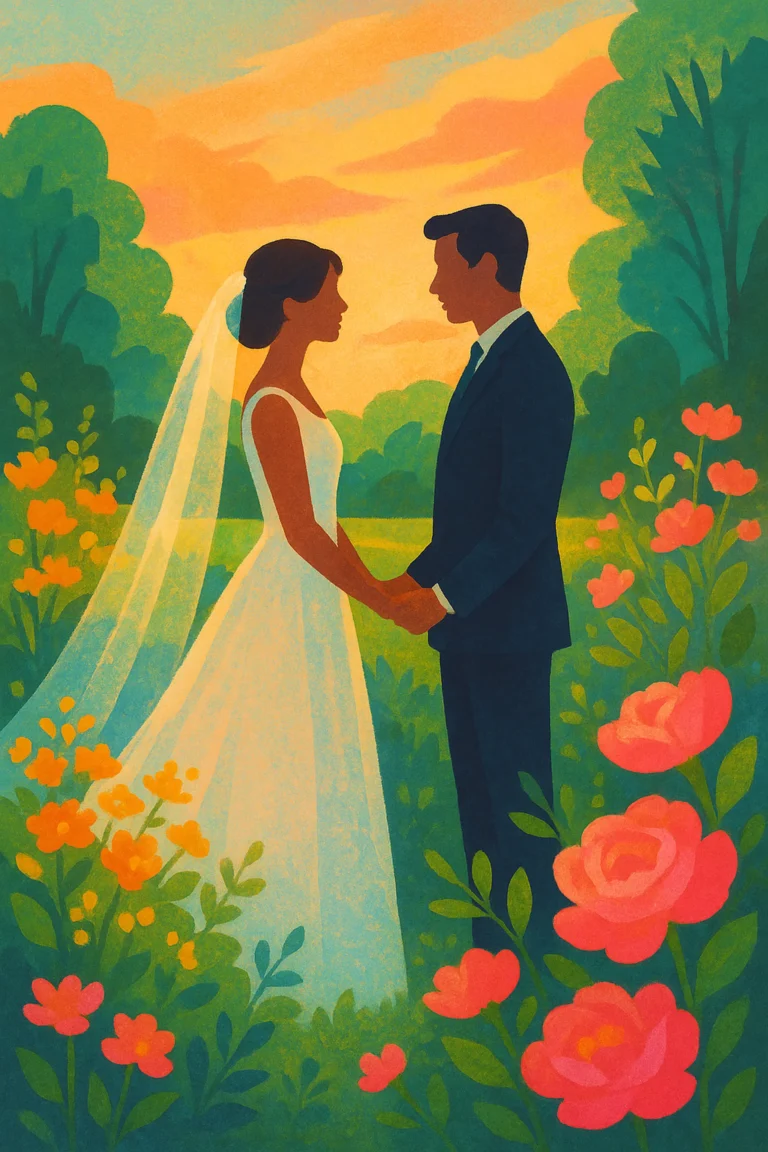AI Answer Box: The key to choosing your wedding bands is to consider your lifestyle, budget and personal style. Decide whether you want both an engagement ring and a wedding band, or if one ring can symbolise both. Look at durable metals like gold, platinum, titanium or modern alternatives like tungsten carbide, and pick a style—plain metal, pavé, eternity or anniversary—that complements your engagement ring and feels comfortable to wear every day.
Getting your wedding rings right is about more than just matching jewellery—it’s about creating a symbol you’ll wear every day that reflects your love story. Whether you’re picking out rings together or planning a surprise, understanding the differences between ring types, materials and styles will help you make a choice that feels timeless and uniquely yours.
Understand engagement rings vs. wedding bands
Your engagement ring typically features a central stone (often surrounded by smaller stones) and is given during the proposal or early in the engagement. A wedding band, on the other hand, is usually a plain metal ring or an eternity band set with diamonds or gemstones that you exchange when you say your vows. Traditionally only one partner receives an engagement ring, but today many couples choose rings for both partners and the etiquette is flexible.
Tip: Because engagement rings tend to have larger stones, wedding bands are often designed to be thinner so they sit flush against the engagement ring. However, there’s no rule saying you have to wear both—it’s your personal choice.
Decide whether you need both rings
Some couples love the symbolism and sparkle of wearing both an engagement ring and a wedding band. Others prefer the simplicity of a single ring that represents both engagement and marriage. Here are reasons for each option:
- Reasons to wear both: Pairing an engagement ring with a wedding band creates a timeless, layered look and clearly signals that you’re married. Stacking rings is on trend, and some brides even layer three or more bands with mixed metals and textures.
- Reasons to wear one ring: A single ring can be more comfortable and less obtrusive; it’s one less ring to worry about losing. You also don’t have to worry about matching a band to your engagement ring, and the budget you would have spent on two rings can go toward a standout single ring.
If you’re unsure, wear your engagement ring alone for a few months. This “test drive” helps you decide if you’d like to add a band later.
Choose the right ring metal
The metal you choose affects the look, durability and price of your rings. Here are the most common options and what they offer:
- Gold: Classic and versatile. Available in yellow, white and rose hues and various karats (10k, 14k, 18k, 24k). Higher karat gold (like 24k) is softer and more prone to scratches, while 10k gold contains more alloy metals and is more durable. White gold usually needs periodic rhodium plating to maintain its bright colour.
- Sterling silver: Affordable and glamorous, but softer than other metals and prone to tarnishing—regular polishing is required.
- Platinum: Hypoallergenic and extremely durable. It retains its colour over time and securely holds stones, making it ideal for people who work with their hands. It’s one of the more expensive metals.
- Palladium: A member of the platinum family, palladium offers a similar look but at a lower price point. It’s lightweight and comfortable but scratches more easily and is harder to resize.
- Titanium: A favourite for men’s rings thanks to its scratch resistance, lightweight feel and modern look. It’s very durable but difficult to resize.
- Stainless steel: Inexpensive, low maintenance and nearly indestructible. However, it can feel heavier than other metals.
- Cobalt: A newer metal option that mimics the look of platinum and white gold. Cobalt is non‑tarnishing and scratch resistant but cannot be resized and scratches can’t be polished out.
- Tungsten carbide: Dark grey and very durable. It is tarnish and scratch resistant but can crack if dropped and cannot be resized.
- Tantalum: A trendy grey‑blue metal that’s hypoallergenic, corrosion‑resistant and affordable. It has a bold, bulky look that may not suit small delicate designs.
Explore wedding band styles
Once you’ve chosen a metal, think about the overall design. According to jewellery experts, the most popular wedding band styles include:
- Metal bands: Simple bands with no gemstones. They’re ideal for active lifestyles and pair with any engagement ring.
- Pavé bands: Bands encrusted with tiny diamonds or gemstones. Perfect if you love sparkle but don’t want a high‑set engagement ring.
- Eternity bands: Rings with diamonds or gemstones around the entire band. Shared prong and channel settings are common options—shared prong offers maximum sparkle while channel set provides a more secure, encrusted look. Eternity bands are ideal if you plan to wear the band alone and want a bold statement.
- Anniversary bands: Similar to eternity bands but stones only go halfway around, making them less bulky. These are great for milestone anniversaries or stacking with your wedding ring later.
When choosing a band style, think about how it will sit with your engagement ring (if you have one) and whether you’ll stack multiple bands. Try different profiles—flat, curved or contoured—to find the most comfortable pairing.
Comfort, fit and lifestyle considerations
The look of your rings is important, but comfort matters just as much because you’ll wear them every day. Keep these tips in mind:
- Get the right size: Have your fingers measured by a jeweller to ensure a snug yet comfortable fit. Keep in mind that finger size can change with temperature and time of day. Wider bands often need slightly larger sizes.
- Choose a profile: Rings come in different profiles like court (rounded), flat or D‑shape. Court profiles have a gentle curve inside and out for comfort, while flat profiles give a modern look with a flat outer edge.
- Match lifestyle: If you lead an active lifestyle or work with your hands, consider durable metals like titanium, tungsten or platinum and avoid high‑set stones that can catch or scratch. A plain metal band may be best for everyday wear.
- Consider future additions: Think about whether you plan to stack anniversary bands later, and choose a style that allows room for additional rings. Some couples prefer matching metals or textures, while others mix metals for contrast.
Care and maintenance
Whichever rings you choose, proper care will keep them looking beautiful. Jewellery experts recommend the following maintenance habits:
- Clean regularly: Soak rings in warm water with mild dish soap and use a soft brush to remove dirt.
- Remove during high‑impact activities: Store rings in a safe place when swimming, gardening, exercising or doing household chores to prevent scratches and dents.
- Avoid harsh chemicals: Take rings off before cleaning with chemicals or using nail polish remover, as they can damage metal and stones.
- Store properly: When not wearing your rings, keep them in a dry, cool place away from direct sunlight to avoid corrosion.
- Visit a jeweller: Have your rings professionally cleaned and checked periodically to ensure settings are secure and to polish away scratches.
Final thoughts & call to action
There’s no one “perfect” wedding ring—only the rings that feel perfect to you and your partner. By understanding the differences between engagement rings and wedding bands, exploring metals and styles and considering your lifestyle, you’ll find pieces that symbolise your commitment and suit your daily life. Take time to try on different metals and band widths, ask jewellers about custom options, and prioritise comfort and meaning over trends.
For more wedding inspiration, explore our guides to custom wedding ring design and buying online and insuring your wedding ring.

